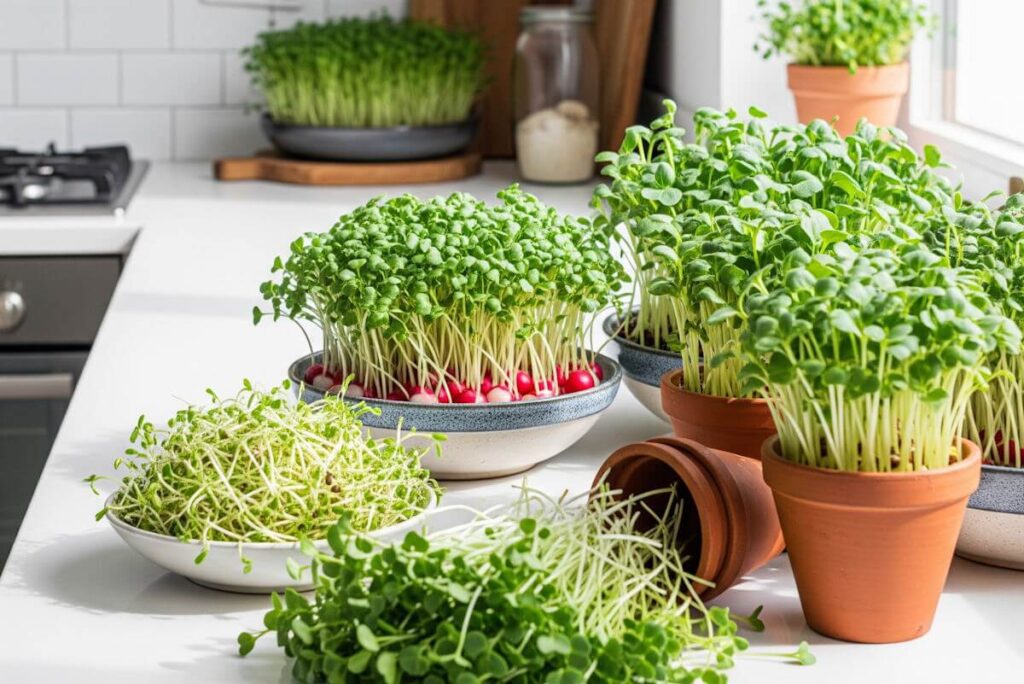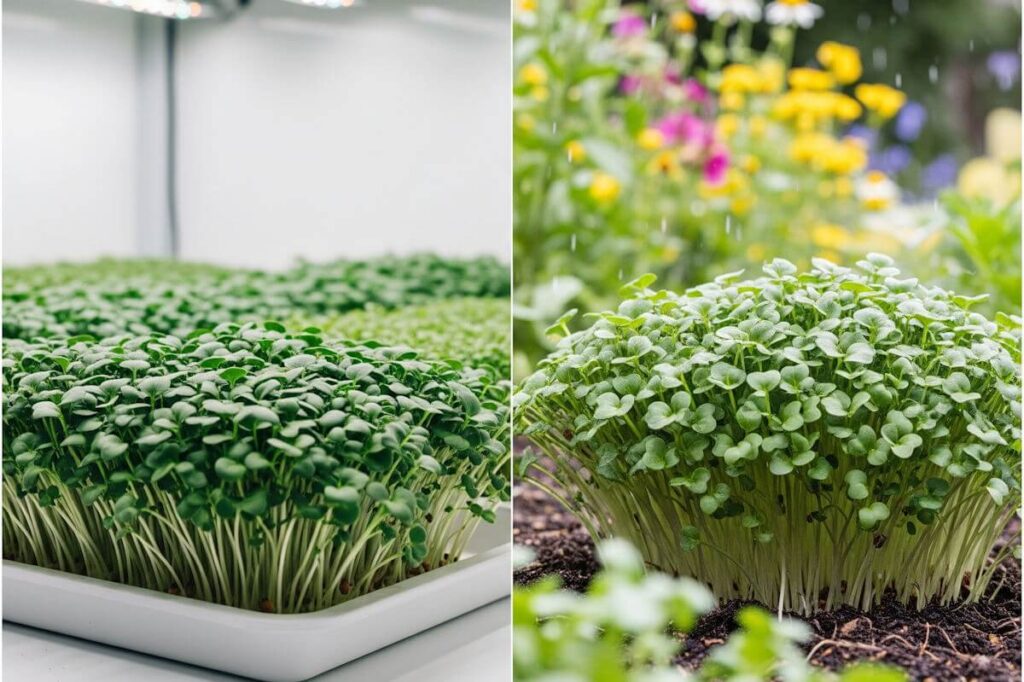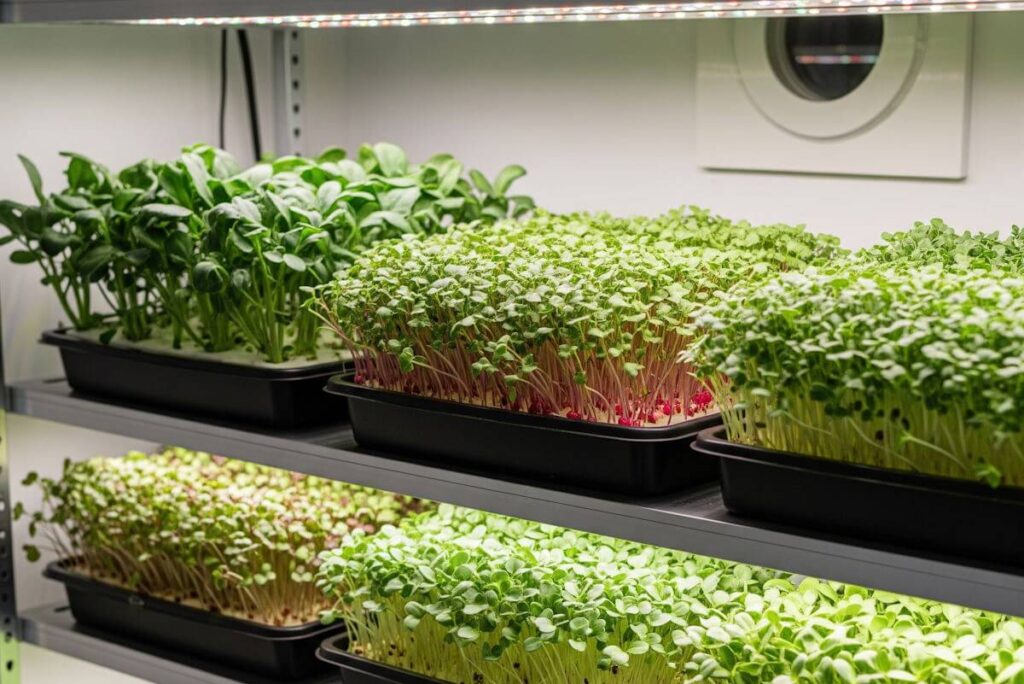Understanding Microgreens: What You Need to Know
Microgreens are young, edible plants collected just after the first true leaves develop. They are typically harvested within 7 to 21 days of germination and can include a wide variety of species, from herbs like basil and cilantro to vegetables such as radishes and beets. Their vibrant colors and concentrated flavors make them increasingly popular among chefs and health-conscious consumers alike.
The types of microgreens are diverse, classified into two primary categories: brassicas and non-brassicas. Brassica microgreens, such as kale, broccoli, and arugula, are known for their high nutritional profile, which includes vitamins C, E, and K along with beneficial antioxidants. Non-brassica options, like sunflower and pea shoots, offer different flavor profiles and nutritional benefits. Understanding the variety of microgreens available can empower local sellers to meet customer demands effectively.
In terms of nutritional benefits, microgreens are often touted for their rich nutrient density. Research indicates that these young plants may contain higher concentrations of vitamins and minerals compared to their mature counterparts. Incorporating microgreens into meals can enhance nutritional value without adding substantial calories. This appeals to health enthusiasts and those seeking to elevate their culinary experiences.
As awareness of the health benefits and culinary possibilities of microgreens grows, so too does their popularity in local markets. Consumers are increasingly looking for fresh, local produce, and microgreens align perfectly with these preferences. By understanding microgreens, sellers can better inform customers about their uses in cooking and the health benefits they provide, while ensuring compliance with local food safety regulations. This knowledge ultimately fosters consumer trust and can enhance a local seller’s reputation in the community.
Regulatory Considerations for Selling Microgreens
When venturing into the business of selling microgreens locally, it is essential to understand and adhere to the various regulations and laws that govern this practice. The sale of microgreens, like any food product, falls under the jurisdiction of state and local health codes. These regulations are in place to ensure that food safety standards are upheld, protecting consumers from potential health risks associated with improperly grown or handled products.
One of the first steps in this process is to determine the necessary permits and licenses required for selling microgreens in your locality. This can vary significantly depending on the region, so it is advisable to contact your local health department or regulatory agency for comprehensive guidelines. In many areas, a food handler’s permit may be necessary, especially if you plan to sell directly to consumers or local markets. Additionally, farmers’ market regulations may stipulate specific requirements for vendors, including product labeling and packaging standards.
Inspections are another crucial aspect of ensuring compliance. Local health departments may require inspections of your growing facilities to ensure they meet safety and sanitary requirements. These inspections often assess factors such as water quality, cleanliness, and pest control measures. Ignoring these regulations can lead to penalties, including fines or, in severe cases, the closure of your business.
Ultimately, complying with state and local regulations is not just a legal obligation but also a means of establishing trust with your customers. By prioritizing food safety and adhering to the requisite standards, you contribute to building a reputable brand in the local market. Ensuring compliance will help you avoid legal complications while promoting healthy practices in your microgreens business.
Food Safety Guidelines for Growing Microgreens
Growing microgreens can be a rewarding venture, but it is essential to understand and implement food safety guidelines to ensure a safe product for consumers. Proper sanitation practices are crucial from the outset of the growing process. Every tool, container, and surface that comes into contact with microgreens should be thoroughly sanitized to prevent the introduction of harmful pathogens. Using food-safe disinfectants and maintaining cleanliness in the growing environment will significantly reduce the risk of contamination.
Avoiding contamination is another vital aspect of food safety in microgreen cultivation. When selecting seeds, it is advisable to source them from reputable suppliers, as contaminated seeds can introduce pathogens to your crop. Additionally, ensure that growing mediums, such as soil or hydroponic systems, are clean and free from contaminants. Pests can also pose a risk; thus, implementing integrated pest management practices is necessary. Regular monitoring of the growing environment for signs of mold, pests, or disease will help in taking preventative measures promptly.
Understanding the potential risks associated with growing microgreens is paramount. Microgreens are often consumed raw, which increases the likelihood of foodborne illnesses if not managed properly. Therefore, growers should be aware of common pathogens that can affect microgreens, such as E. coli and Salmonella, particularly when using organic fertilizers or water sources that may harbor these bacteria. Conducting routine testing of water quality and employing good agricultural practices, including rotating crops and avoiding overcrowding, can further mitigate risks.
Incorporating these food safety guidelines into your microgreen cultivation process will help ensure that your product is both safe and of high quality, which is essential for building trust with local customers and enhancing your reputation as a producer.
Labelling Requirements for Microgreens
When selling microgreens locally, adhering to specific labeling requirements is crucial to not only ensure compliance with local regulations but also to foster consumer trust. Proper labeling involves including various mandatory details that inform consumers about the product they are purchasing. This information encompasses product names, a comprehensive list of ingredients, potential allergens, and expiration dates, each playing a key role in product transparency.
The product name should clearly indicate that it is microgreens, supplemented by the specific type, such as “Radish Microgreens” or “Broccoli Microgreens.” This specificity helps consumers identify the exact product they are interested in. Additionally, it is essential to list all ingredients used, especially if the microgreens are part of a mix or include any additives.
Allergens represent another critical aspect. Any common allergens present in the product should be highlighted to alert individuals who may have sensitivities or allergies. For instance, if the microgreens are processed in an area that handles nuts or gluten, that information should be readily available on the label.
Furthermore, it is imperative to include expiration dates or best-by dates to ensure that consumers are informed about the freshness of the microgreens. Fresh produce like microgreens has a limited shelf life, and clear dating aids buyers in making informed decisions, enhancing safety and quality assurance.
Accurate labeling not only complies with local legal standards but also builds consumer confidence. When customers can easily access relevant information regarding the microgreens they intend to purchase, they are more likely to trust the product and the seller. By following these labeling guidelines, local sellers can ensure that they meet legal obligations while promoting their microgreens effectively.
Packaging Standards for Microgreens
When selling microgreens locally, the choice of packaging plays a pivotal role in maintaining product quality and ensuring consumer safety. Various packaging options are available for microgreens, each with its benefits and drawbacks. It is vital to select materials that not only preserve the freshness of the microgreens but also comply with food safety regulations.
Plastic clamshell containers are among the most popular choices for microgreens. They offer visibility, allowing customers to see the vibrant colors and condition of the greens, while also providing ventilation to reduce moisture buildup, which can lead to spoilage. However, it is essential to ensure that the plastic used is food-safe and BPA-free to prevent any chemical leaching into the products. Alternatively, biodegradable packaging, such as compostable bags or containers made from plant-based materials, is becoming increasingly popular due to its sustainability aspect. Such options cater to environmentally conscious consumers and help reduce the environmental footprint of the microgreens business.
Moreover, incorporating proper labeling on the packaging is crucial for regulatory compliance. Labels should provide essential information, including product name, weight, origin, and any allergen information as required by local food safety laws. Additionally, a clear expiration date or best-before date should be included to inform consumers about the freshness of the product.
In terms of preservation, using moisture-resistant packaging materials can significantly extend the shelf life of microgreens. Thus, single-use ethylene gas-absorbing packets can also be included to inhibit spoilage, thereby maintaining the quality during transport and storage. Overall, selecting the right packaging is instrumental in ensuring that microgreens remain fresh, safe for consumption, and compliant with regulatory standards while appealing to customers.
Handling and Transportation Best Practices
Ensuring the safe handling and transportation of microgreens is crucial in maintaining their freshness, quality, and safety. The first essential practice is temperature control. Microgreens are sensitive to temperature fluctuations; thus, it is imperative to keep them at a consistent temperature throughout the transportation process. Ideally, refrigeration should be used to maintain a cool environment that prevents wilting and spoilage. The recommended temperature for storing microgreens is between 32°F and 40°F (0°C to 4°C), which helps preserve their nutritional value and extends shelf life.
Another important aspect is transportation hygiene. The containers used to transport microgreens should be clean and sanitized to minimize the risk of contamination. It is advisable to use food-grade materials that are specifically designed for this purpose. Before loading microgreens, ensure that all surfaces are free of any residues or contaminants. Additionally, ensure that the transportation vehicle is clean and properly maintained to prevent any possible cross-contamination from other food products.
To further mitigate the risk of spoilage or contamination during delivery, microgreens should be packed securely to prevent them from being crushed or damaged. Utilizing breathable packaging materials allows for air circulation, which can help prevent moisture buildup that may lead to spoilage. Proper packing also ensures that the microgreens arrive at their destination in pristine condition.
Lastly, establishing a rapid delivery process is essential for preserving the quality of microgreens. Whenever possible, aim for direct delivery routes to minimize the time spent in transit. Communicating with customers about the importance of prompt storage upon receipt can also help ensure that they maintain the appropriate conditions for the microgreens at their location, thereby enhancing their overall experience.
Building Customer Relationships and Trust
Establishing strong customer relationships and fostering trust within the local community are crucial components for any successful microgreens business. Consumers today are increasingly discerning, and they seek not only high-quality products but also assurance regarding the safety and sustainability of what they purchase. Building these relationships goes beyond mere transactions; it entails meaningful engagement and communication that resonates with local customers.
Effective communication is key when it comes to sharing safety practices and production methods. Sharing your farming techniques, such as organic growing practices and pest management strategies, can help customers feel more confident in your products. Transparency about your microgreens’ lifecycle, from seed sourcing to the harvesting process, can set your business apart and display your commitment to quality and safety. Using social media platforms or hosting community events allows you to showcase these practices while also creating personal connections with customers.
Additionally, consider obtaining certifications or licenses related to food safety. Displaying these certifications prominently can provide reassurance that you adhere to health guidelines. Customers are more likely to support businesses that demonstrate accountability and reliability in their operations. Encouraging customer feedback is another avenue to cultivate trust. By actively responding to suggestions and concerns, you can further enhance your relationship with your clientele, showing them that their opinions matter.
Moreover, offering samples at local markets or establishing loyalty programs can contribute to stronger customer bonds. By creating opportunities for customers to experience your microgreens firsthand, you not only demonstrate the quality of your products but also encourage repeat business. Ultimately, these strategies will lead to a healthier brand reputation and a thriving community of satisfied customers who feel connected to your microgreens business.
Staying Updated on Food Safety Regulations
In the dynamic world of microgreens, it is imperative for sellers to be vigilant and proactive in staying informed about food safety regulations. These regulations are essential for ensuring the health and safety of consumers, and they can frequently change based on new research, public health recommendations, and legislative updates. Consequently, microgreen sellers must take the initiative to understand and comply with these evolving standards.
One effective strategy for keeping abreast of food safety regulations is to join local farming groups or organizations. These groups often serve as valuable resources, providing members with updates on best practices, compliance requirements, and changes in local laws. Networking with fellow growers can also facilitate information sharing and the opportunity to learn from others’ experiences in navigating the regulatory landscape.
Additionally, subscribing to newsletters from reputable sources, including government agencies such as the U.S. Food and Drug Administration (FDA) or local health departments, can be instrumental. These newsletters typically include information regarding new food safety initiatives, policy changes, and practical guidelines for small-scale farmers. By receiving these updates directly to their inbox, microgreen sellers can quickly adjust their practices to align with current regulations.
Attending workshops and seminars focused on food safety is another effective way to stay engaged with regulatory developments. Many agricultural extension services and local universities offer training sessions that cover compliance with food safety standards, as well as testing methods to ensure product safety. Participation in these educational events not only increases knowledge but also fosters a sense of community among growers, making it easier to keep track of regulatory obligations.
In conclusion, staying updated on food safety regulations is crucial for microgreen sellers to maintain compliance and ensure consumer safety. By actively engaging with local farming groups, subscribing to relevant newsletters, and attending workshops, sellers can navigate the complexities of food safety with greater ease and confidence.
Resources and Support for Local Microgreen Sellers
For individuals venturing into the local microgreen market, a wealth of resources is available to aid in compliance with legal requirements and enhance food safety practices. These resources play a crucial role in ensuring successful business operations, offering essential support and education.
Government agencies provide a range of resources that can significantly benefit microgreen sellers. The U.S. Department of Agriculture (USDA) offers guidelines on agricultural policies and food safety regulations. Local health departments often provide information on permits and food safety standards, allowing sellers to understand their legal obligations. Additionally, utilizing your state’s agricultural extension service can provide insight into best practices, crop management, and pest control specifically tailored for microgreens.
Online forums and communities dedicated to microgreens also serve as valuable platforms for information sharing. Websites such as Microgreens Farmer and various social media groups bring together growers who exchange tips on cultivation, marketing strategies, and legal compliance. Networking in these forums can lead to fruitful partnerships and provide sellers with timely advice from seasoned growers.
Community workshops and local seminars offer hands-on training and knowledge-sharing opportunities, often conducted by agricultural experts or successful microgreen entrepreneurs. These events may cover a broad spectrum of topics, including best farming practices, packaging, branding, and navigating local regulations. By participating in these workshops, microgreen vendors can better understand not only the production side but also market trends that can inform their business strategies.
Finally, local agricultural co-operatives can serve as a vital resource for microgreen sellers. These organizations can facilitate access to shared equipment, marketing assistance, and logistical support to help grow your microgreen business sustainably. Access to such resources fosters a supportive environment for emerging microgreen sellers, ultimately contributing to their success and compliance in the local market.




